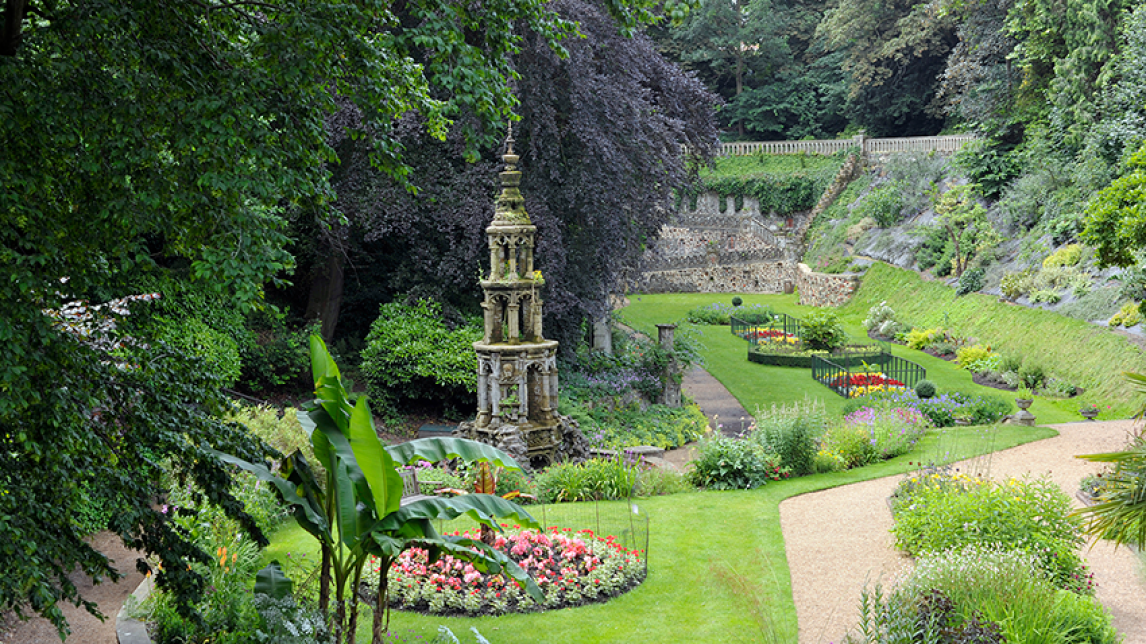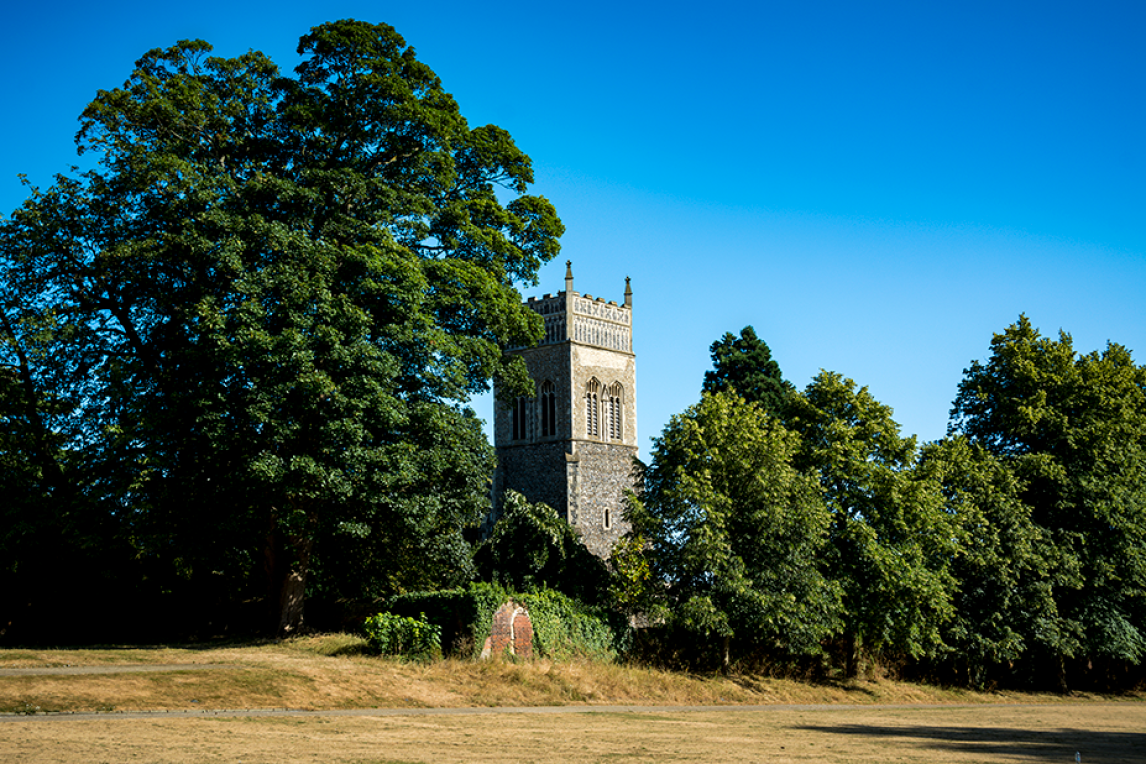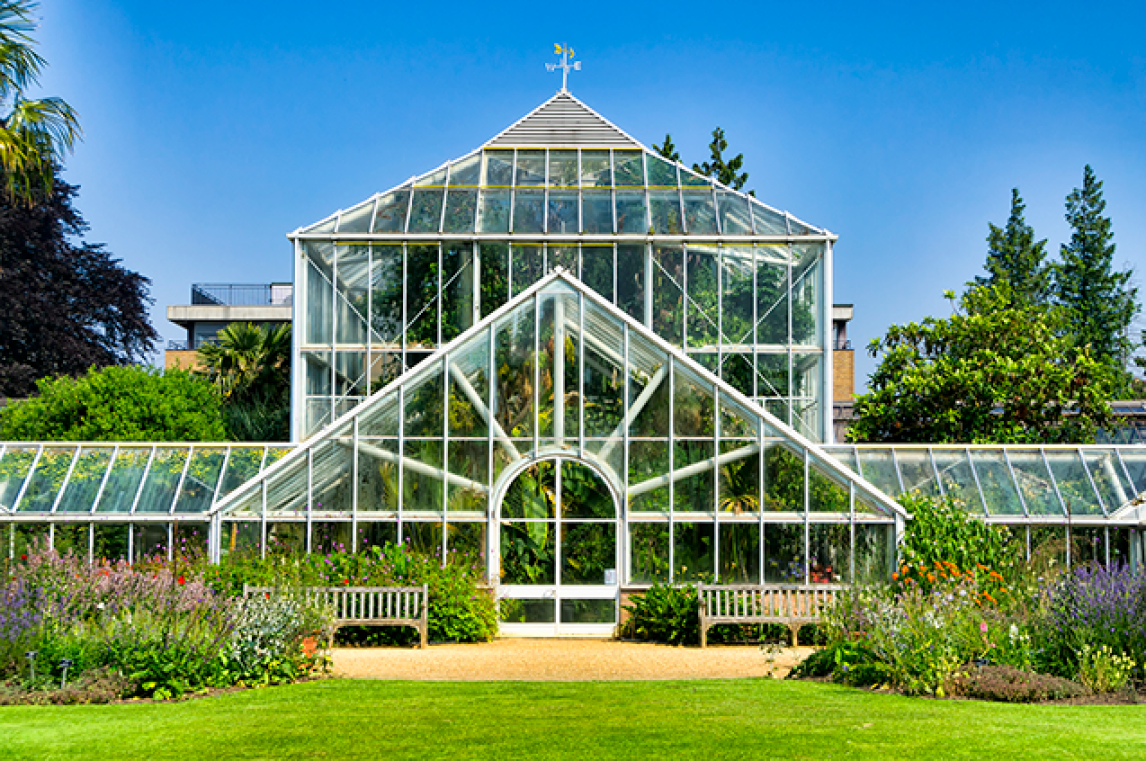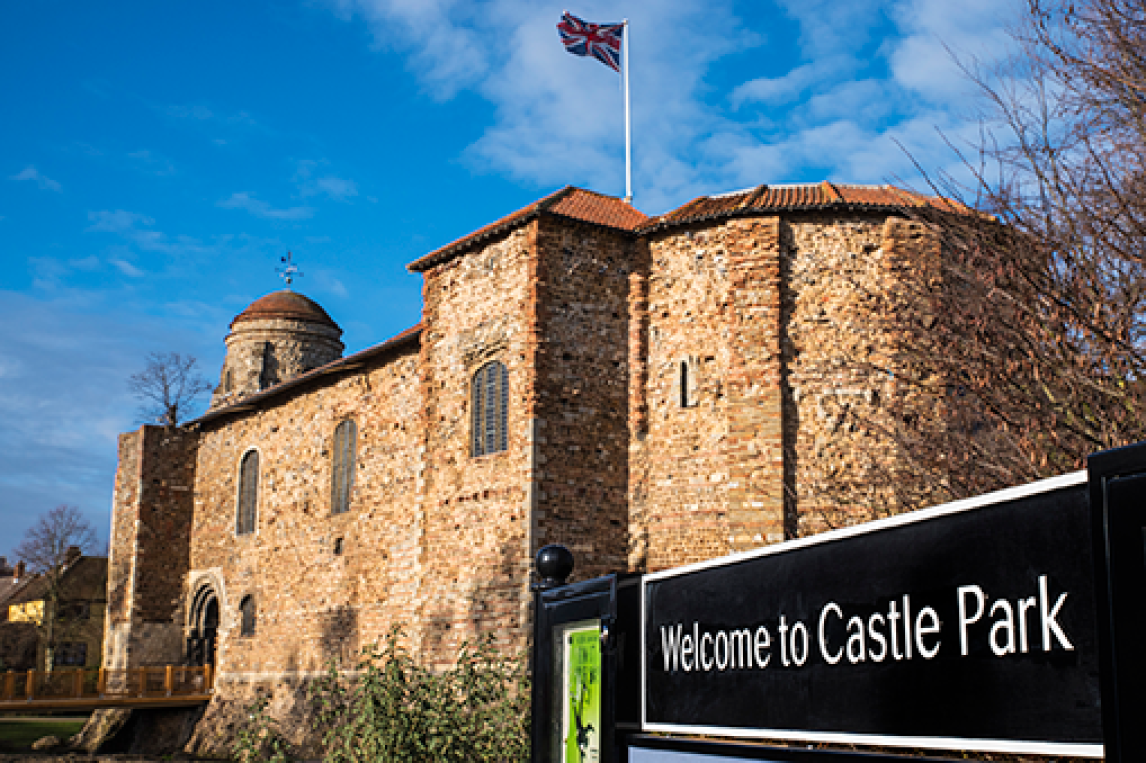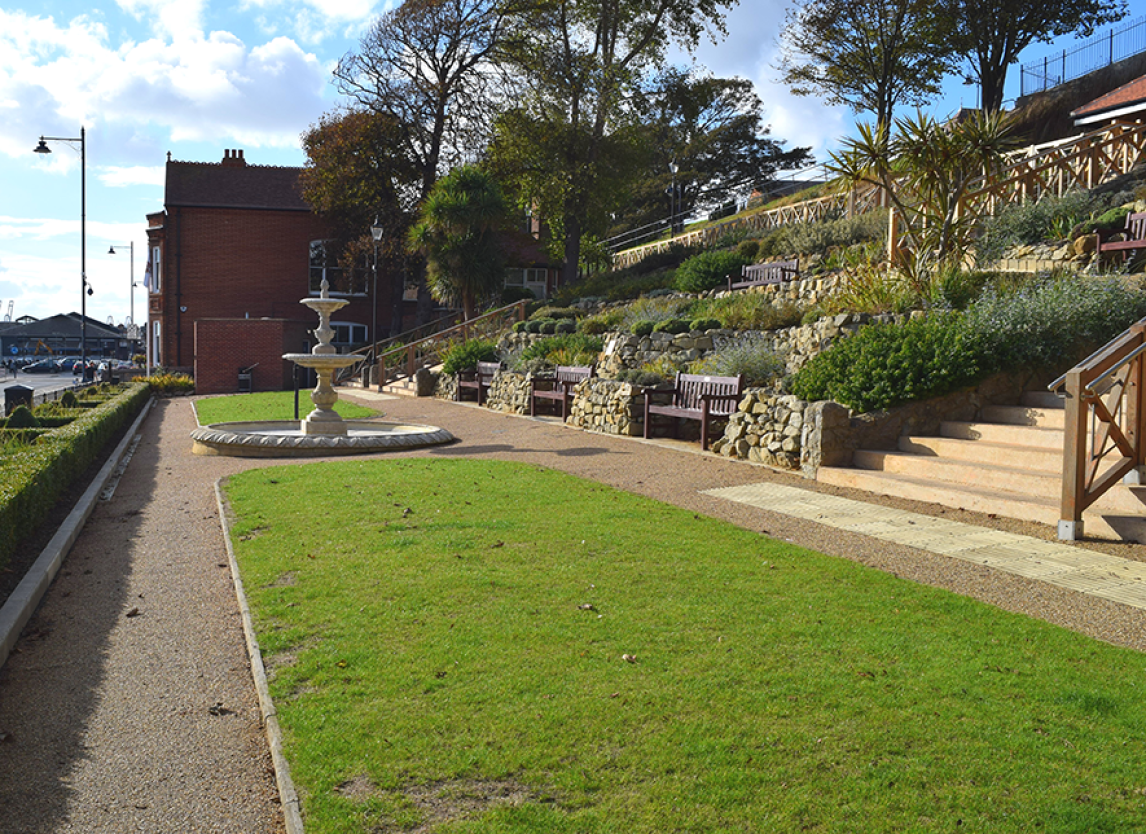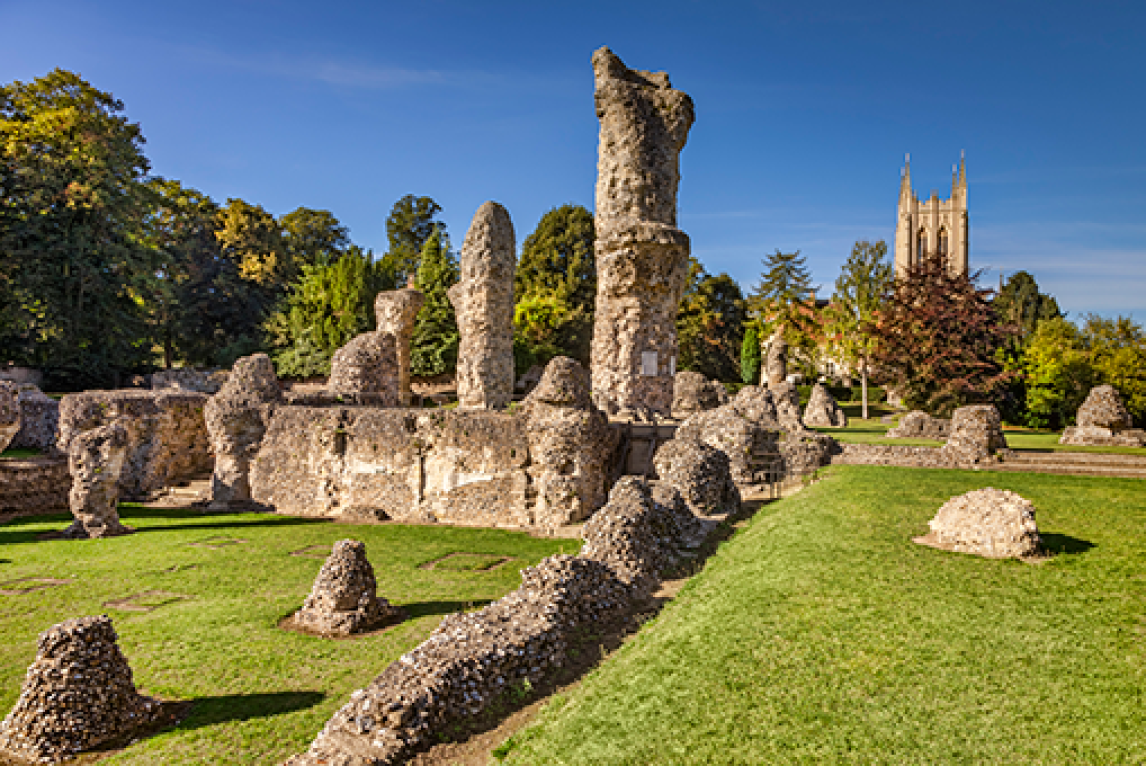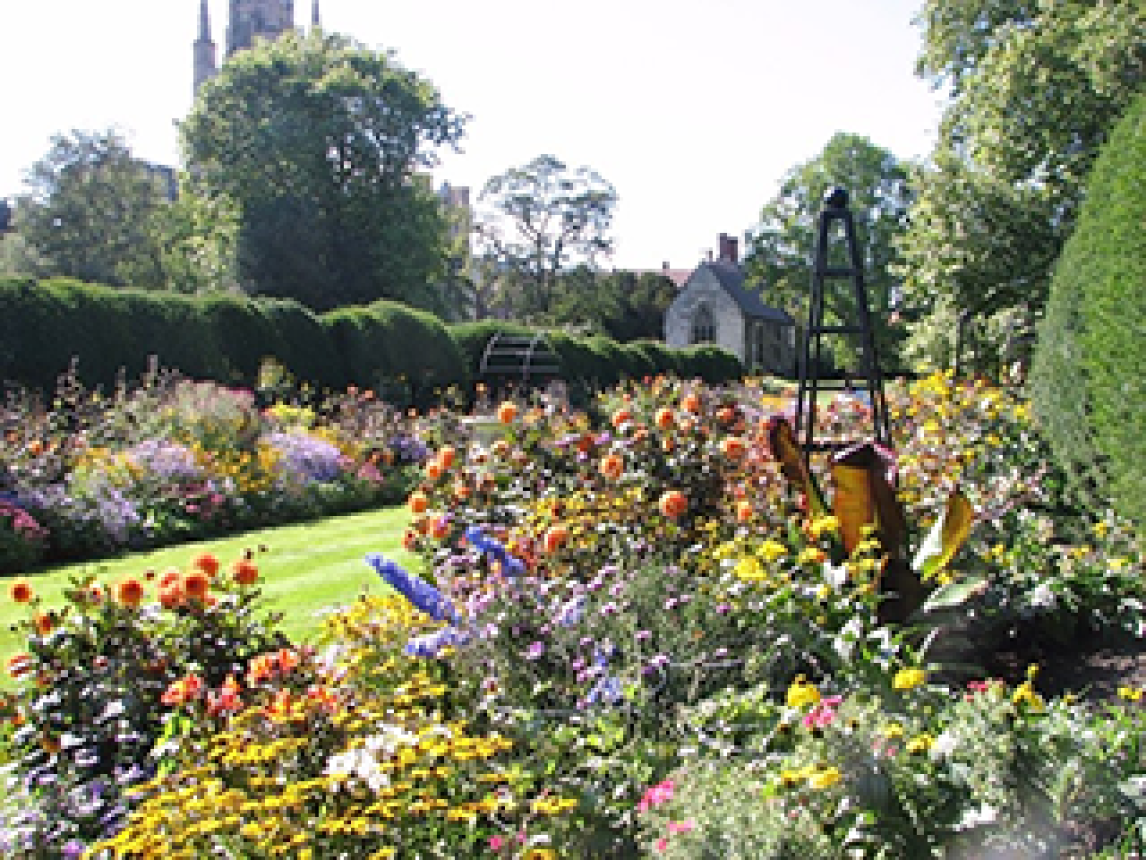Words by Emma Pocklington
It’s National Gardening Week between 27 April and 5 May, and many of East Anglia’s best gardens are accessible by train. Often concealed within the heart of the region’s towns and cities, here are our favourite hidden green havens…
The Plantation Garden
Plantation House was built in 1856 by local upholsterer and cabinet-maker Henry Trevor. Having achieved great success with his local business, Henry was able to construct his large house and lavish garden – situated on the site of an old quarry in Norwich – at great expense. Elaborate and decadent in its design, the garden was laid out complete with gothic fountain and rustic summer house. In 1929, the Plantation ceased to be a private house and became first a private clinic and then a hostel for midwives in training. The garden then fell into disuse until 1980. After a period of restoration, the garden was opened to the public as one of the finest surviving Victorian gardens in England, and a Grade II listed site.
Known to locals as “The Secret Garden”, the Plantation Garden is a place of peace and tranquility in the city. Stroll around three acres of winding paths, hidden corners and colourful flowerbeds. The rustic bridge at one end and the Italian terrace at the other afford fine views of the garden, and there are also a wealth of follies, historic features and woodland walkways to enjoy. Extend your visit by taking a guided tour or enjoying an illustrated talk, both explaining the garden’s history, creation and management.
When: Open every day of the year from 9am–6pm
Cost: Admission £2, free to members
Nearest station: Norwich
Christchurch Park
A sprawling 33 hectares that leads right into the heart of Ipswich, Christchurch Park is not only one of the city’s conservation areas, but is also a designated County Wildlife Site, and is Grade II listed. Previously part of the land owned by a priory (destroyed in the dissolution of the monasteries) the park became the grounds of Christchurch mansion – a Tudor brick mansion built from 1548 – before opening to the public in 1895. It was restored and officially reopened in 2008, and today features a huge number of public facilities as well as some rare urban plants.
Wander among 300–400-year-old veteran oaks and sweet chestnut trees, and search for wildlife among ponds, grasslands and woodland. The red brick Tudor mansion sits astride it all, but there is also an ice house and cabman shelter to see. Close to the wilderness pond, the wet meadow and butterfly garden is rich with wildlife, and the wooded wildlife reserve is home to treecreepers, tawny owls, pipistrelle bats and stag beetles.
When: Check the website for seasonal opening times
Cost: Free
Nearest station: Ipswich
Cambridge University Botanic Garden
Close to Cambridge train station sits the spectacular Cambridge University Botanic Garden , boasting around 8,000 species of plants from all over the world.
Founded in 1762, the garden began as a resource for medical students, before being moved to a larger site in 1846. Today, this garden is as much a benefit for local wildlife as it is for the students. The garden is home to muntjac deer, foxes and even a badger sett. Hissing Sid the grass snake enjoys the palm house, and a plethora of birds, butterflies and other bugs can be seen.
There is a vast collection of gardens to choose from here. Visit the Old Pinetum to walk among the trees that date back to the garden’s founding, or the scented garden to stimulate the senses. The bog garden is a sheltered microclimate for marginal plants, and the grass maze will keep the kids entertained. There are also autumn and winter gardens, a dry meadow, a British wild plant garden, a fen display, bee borders, a glasshouse range, a rock garden, Mediterranean beds and much more. The garden also offers practical, creative and education workshops and courses, as well as seasonal tours with trained guides.
When: See the website for seasonal opening times
Cost: £6 for adults, children 0–16 go free
Nearest station: Cambridge
Castle Park
Mentioned by Pliny the Elder before his death in AD79, Colchester claims to be the oldest town in Britain, and 2,000 years of history can be seen at the town’s Castle Park. Divided into the Upper Park and Lower Park by the Roman Wall, the park spans and area of 11 hectares and is Grade II listed.
A tranquil setting in the heart of this busy market town, Castle Park is a place to step back in time and unwind. Get tactile in the sensory garden, or while away and afternoon on the boating lake. The park is home to over 600 mature trees, and also contains two gardens to commemorate the twinning of Colchester with other towns – the Avignon Garden commemorates the twinning with Avingon in France in 1972, and the Wetzlar Garden celebrates the twinning with Wetzlar, Germany in 1979.
When: Check the website for seasonal opening times
Cost: Free
Nearest station: Colchester Town
Felixstowe Seafront Gardens
Spanning the area from the seafront to the town high up on the cliff, the Felixstowe Seafront Gardens are an impressive sight. Grade II listed, the gardens are thought to have existed since the 18th century, acting as separate gardens connected to seafront houses. In 1891, Felixstowe was a popular tourist destination, thanks to the Felixstowe Spa, and the boom in Victorian seaside holidays meant that people flocked to Felixstowe to benefit from the natural springs. During this time the gardens around the seafront offered a relaxing pleasure ground for visiting tourists.
The gardens were finally combined and gifted to the town by their private owners in 1952. Today they are interconnected and stretch for almost a kilometre along the promenade. Marvel at the ordered beauty of the rose garden and the Town Hall Gardens, or trek up the winding path to the Serpentine Steps. At the Wishing Well and Dripping Pond, relax around the same water features that entertained Victorian holidaymakers.
When: Always open
Cost: Free
Nearest station: Felixstowe
Abbey Gardens
Created in 1831 on the site of the ruined Abbey of St Edmund, this award winning 14-acre park in Bury St Edmunds was originally constructed as a botanic garden. In 1937, the garden was redesigned for the coronation celebrations of George VI, and the layout remains largely the same today.
Today, the summer display of around 20,000 plants, and the spring display of around 12,000 plants and 20,000 bulbs, are framed by the abbey wall, which runs from the 13th Centre Abbot’s Bridge via the imposing Abbey Gate to St Edmundsbury Cathedral.
Step back in time as you wander the extensive ruins of the abbey and investigate the traditional plants in the Pilgrim’s Herb Garden. The Appleby Rose Garden is home to over 400 rose buses, and the Abbey Garden Sundial Fountain was gifted to the people of Bury St Edmunds in 1871. Don’t miss the Sensory garden, the Garden of Reflection, the Water garden, and the scenic stroll along the River Lark. The garden also contains the world’s first internet bench!
When: Check website for seasonal opening times
Cost: Free
Nearest station: Bury St Edmunds
Bishop’s House Gardens
Enjoy a true hidden secret in Norwich this summer when the private Bishop’s House Gardens open to the public, to raise money for local charities.
Nestled in the centre of the city, this four-acre garden has existed in some form since around 1100 AD, when Bishop de Losinga began to build the cathedral and palace – the original Norman stonework of the North Transept of the cathedral is still visible from the garden.
The garden was extended in the 14th century, and the walls built 700 years ago still survive today, as well as a number of ruined buildings from the medieval era.
Stroll around herbaceous borders, a small woodland walk, boxed rose beds, an organic kitchen garden and a wild grass labyrinth. There are many rare and unusual plants here, including a Hebe planted from a sprig taken from Queen Victoria’s wedding bouquet in 1840.
When: Open on various dates 12 May–7 July
Cost: Adults £4, children free
Nearest station: Norwich



